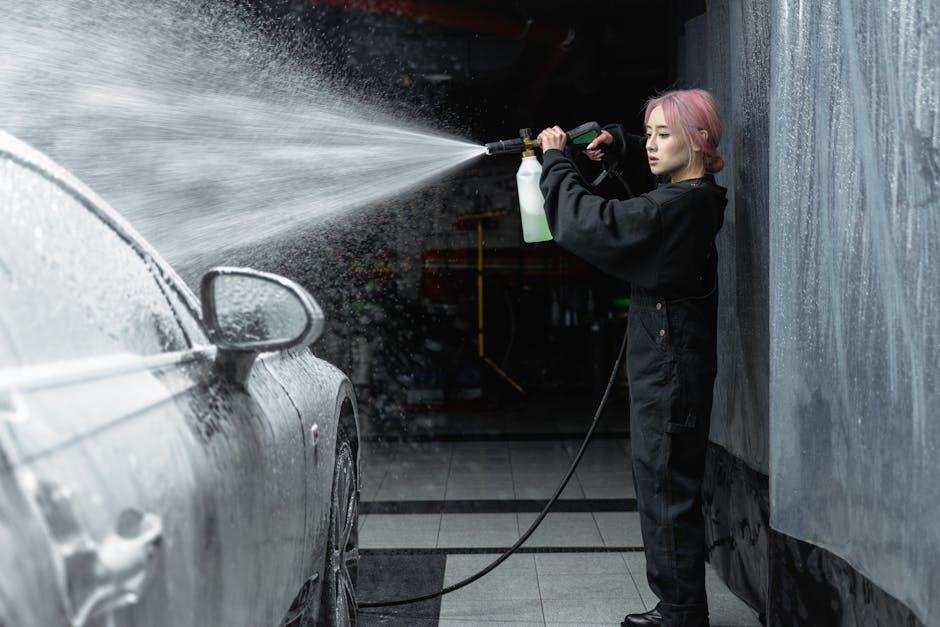Brake fluid is the silent guardian behind every smooth stop and safe journey, working tirelessly within your vehicle’s braking system to ensure you come to a controlled halt when it matters most. Yet, despite its crucial role, brake fluid often goes unnoticed—hidden away, out of sight and mind. Knowing when to change this humble but vital fluid can mean the difference between confident braking and unexpected failure. In this article, we’ll explore the signs, timelines, and reasons that signal it’s time for fresh brake fluid, helping you keep your vehicle’s stopping power sharp and your drives secure.
Table of Contents
- Understanding the Role of Brake Fluid in Vehicle Safety
- Signs That Indicate Your Brake Fluid Needs Changing
- How Often Should You Replace Brake Fluid for Optimal Performance
- The Impact of Contaminated Brake Fluid on Braking Efficiency
- Step-by-Step Guide to Checking and Changing Brake Fluid
- Professional Recommendations and Common Maintenance Mistakes to Avoid
- Q&A
- Key Takeaways

Understanding the Role of Brake Fluid in Vehicle Safety
Brake fluid serves as the lifeblood of your vehicle’s braking system, transferring the force from your brake pedal directly to the brake pads and discs. Over time, however, this crucial fluid absorbs moisture from the air, which dilutes its effectiveness and raises the risk of brake failure under extreme conditions. Maintaining optimal brake fluid quality is essential not only for performance but for your safety on the road. Recognizing the signs of degraded brake fluid—such as a spongy brake pedal, longer stopping distances, or warning lights on the dashboard—can be lifesaving.
To ensure your brake system remains responsive and reliable, regular checks and timely fluid changes are advised. Many manufacturers recommend changing brake fluid every 2 to 3 years, but driving habits and environmental factors can necessitate more frequent maintenance. Consider the following key points to protect your braking system:
- Check brake fluid color: Clear or light amber indicates good condition, dark or murky means it’s time for a change.
- Monitor moisture content: Moisture above 3% in brake fluid compromises safety and should prompt immediate attention.
- Observe vehicle performance: Any decrease in braking responsiveness is a warning sign.
| Brake Fluid Type | Change Interval | Moisture Tolerance |
|---|---|---|
| DOT 3 | Every 2 years | Up to 3% |
| DOT 4 | Every 1-2 years | Up to 3% |
| DOT 5.1 | Every 2 years | Up to 3% |

Signs That Indicate Your Brake Fluid Needs Changing
Discerning the need to change your brake fluid often comes down to recognizing subtle but critical warnings. One of the primary indicators is a spongy or soft feeling when pressing the brake pedal. This sensation usually means that the fluid has absorbed moisture or air bubbles, compromising its ability to transfer pressure effectively. Additionally, if you notice the brake warning light illuminating on your dashboard, it could signal low fluid levels or degraded fluid quality that demands immediate attention.
Visual signs are equally telling. Brake fluid naturally darkens over time due to contamination and heat exposure. A routine check of the reservoir can reveal this change from a clear amber to a murky brown or black hue. Below is a quick reference chart summarizing brake fluid conditions and associated signs to help you assess when a change is due:
| Brake Fluid Condition | Signs | Recommended Action |
|---|---|---|
| Clear Amber | Normal appearance, no brake issues | Continue regular use, check annually |
| Darkened, Brown | Soft brake pedal, cloudy fluid | Schedule brake fluid replacement soon |
| Black or Contaminated | Brake warning light on, spongy brakes | Immediate brake fluid change required |

How Often Should You Replace Brake Fluid for Optimal Performance
Brake fluid is essential for your vehicle’s safety and should never be overlooked in your maintenance routine. Typically, manufacturers recommend changing brake fluid every 2 to 3 years, but this timeline can vary based on driving habits, climate, and the type of brake fluid used. Over time, brake fluid absorbs moisture from the air, which reduces its boiling point and can lead to decreased braking efficiency or even system damage under heavy braking conditions. Ignoring fluid replacement can result in a spongy brake pedal or, worse, failure when you need it most.
Regular inspection is key. Here’s a quick checklist to help you monitor your brake fluid condition:
- Check fluid color: Fresh fluid is clear or light amber, dark or murky fluid indicates contamination.
- Monitor for moisture content: Ideally, moisture should be below 3%; above 3% calls for a fluid change.
- Note vehicle usage: Frequent stop-and-go or mountainous driving may require more frequent changes.
| Brake Fluid Type | Recommended Change Interval | Typical Color When Fresh |
|---|---|---|
| DOT 3 | Every 2 years | Clear, light amber |
| DOT 4 | Every 2-3 years | Clear, light yellow |
| DOT 5 (Silicone) | Every 3-5 years | Purple or clear |

The Impact of Contaminated Brake Fluid on Braking Efficiency
Over time, brake fluid can absorb moisture from the air due to its hygroscopic nature, leading to contamination. This water infiltration drastically reduces the fluid’s boiling point, which in extreme conditions causes vapor pockets to form inside the brake lines. When these vapor bubbles appear, the normally firm resistance of the brake pedal becomes spongy and inconsistent, compromising your ability to stop quickly and safely. Additionally, contaminated brake fluid may accelerate corrosion within critical brake system components, such as calipers and master cylinders, leading to premature wear and costly repairs.
Maintaining clean brake fluid is essential for consistent braking performance. Here are some key effects of contaminated brake fluid on your vehicle:
- Reduced braking response: Increased stopping distances caused by fluid vaporization under pressure.
- Brake fade: Gradual loss of braking power during extended or intense braking.
- Corrosion risk: Internal damage to brake components resulting in leaks and system failure.
| Brake Fluid Condition | Boiling Point (°C) | Effect on Braking |
|---|---|---|
| New Fluid | 260 | Optimal performance, reliable stopping power |
| Moderately Contaminated | 180 | Noticeable pedal softening, reduced efficiency |
| Highly Contaminated | 140 | Spongy pedal, increased stopping distance, danger signs |

Step-by-Step Guide to Checking and Changing Brake Fluid
Begin by locating the brake fluid reservoir under the hood, usually found near the back of the engine bay on the driver’s side. Before opening, clean the reservoir cap to prevent contaminants from entering. Remove the cap and inspect the fluid color through the translucent reservoir or by dipping a clean tool inside. Fresh brake fluid is typically clear or light amber, while dark or muddy fluid indicates it’s time for a change. Use a brake fluid tester strip if you want to be extra sure about moisture content, which is a primary cause of brake fluid degradation.
Changing the brake fluid requires special attention to detail and safety. Start by preparing your tools: a brake bleeder kit, fresh brake fluid recommended by your vehicle’s manufacturer, and protective gloves. You’ll need to bleed the system, which involves releasing old fluid from each brake caliper or wheel cylinder while pumping in new fluid from the reservoir. Maintain the reservoir at the recommended level throughout to prevent air from entering the system. Here’s a simple checklist to guide you through the bleeding process:
- Step 1: Attach the bleeder kit hose securely to the brake caliper’s bleeder valve.
- Step 2: Have an assistant pump the brake pedal slowly and hold it down.
- Step 3: Open the bleeder valve to let out the old fluid, then close it before the pedal is released.
- Step 4: Repeat this until clear fluid runs through and no bubbles appear.
- Step 5: Move to the next brake and repeat the process, usually starting with the wheel farthest from the master cylinder.

Professional Recommendations and Common Maintenance Mistakes to Avoid
To keep your braking system in optimal shape, experts often recommend changing brake fluid every 2 years or 30,000 miles, whichever comes first. This schedule can vary based on driving habits and vehicle model, so always check your manufacturer’s guidelines. A professional brake service typically involves flushing the old fluid entirely, ensuring contaminants and moisture don’t compromise brake efficiency. Using high-quality, compatible brake fluid is crucial—mixing different types can lead to system corrosion and reduced performance.
Many enthusiasts fall into common maintenance pitfalls that can significantly shorten brake system life or even jeopardize safety. Beware of:
- Neglecting Visual Checks: Even if the fluid change timeline hasn’t arrived, cloudy or dark brake fluid signals contamination.
- DIY Fluid Topping: Simply adding new fluid without flushing the old one leaves moisture and debris behind.
- Ignoring Brake Warning Signs: Spongy pedals or reduced responsiveness often mean fluid issues overdue for attention.
| Maintenance Tip | Common Mistake |
|---|---|
| Flush complete system | Only topping up fluid |
| Use recommended fluid type | Mixing incompatible fluids |
| Follow vehicle-specific schedules | Changing fluid by time only |
Q&A
Q&A: Brake Fluid – When to Change It
Q: Why is brake fluid important for my vehicle?
A: Brake fluid is the lifeblood of your braking system. It transfers the force from your pedal to the brake pads, ensuring your car stops safely. Without clean, effective brake fluid, your brakes can become sluggish or even fail.
Q: How often should I change my brake fluid?
A: Typically, brake fluid should be changed every 2 years or 30,000 miles, but this can vary depending on your car’s make and driving conditions. Always check your owner’s manual for manufacturer recommendations.
Q: What signs indicate it’s time to change brake fluid?
A: Warning signs include a spongy brake pedal, longer stopping distances, or if the brake fluid looks dark and cloudy instead of clear or amber. Also, if you notice moisture in the fluid—brake fluid is hygroscopic and absorbs water over time—it’s a clear signal to flush and replace it.
Q: Can I just top off the brake fluid instead of changing it?
A: Topping off can help maintain fluid levels but doesn’t address contamination inside the system. Over time, brake fluid absorbs moisture and collects debris, both of which compromise braking efficiency. A full flush and replacement is the safest option.
Q: What happens if I neglect brake fluid maintenance?
A: Old or contaminated brake fluid can lead to corrosion in brake components, degraded braking performance, and even brake failure. Neglect can put you and others on the road at serious risk.
Q: Is changing brake fluid something I can do myself?
A: While possible for experienced DIYers, brake fluid changes require careful bleeding of the brake system to remove air pockets. Improper procedure can compromise brake safety. For most drivers, professional service is recommended.
Q: Does driving style affect how soon brake fluid should be changed?
A: Yes. Frequent stop-and-go traffic, heavy braking, or driving in humid conditions can introduce more moisture into the system, warranting more frequent fluid changes.
Q: What type of brake fluid should I use?
A: Brake fluid types vary (DOT 3, DOT 4, DOT 5, etc.) and are not interchangeable due to different chemical properties. Always use the type specified in your vehicle’s manual.
Q: How can I extend the life of my brake fluid?
A: Regular brake inspections and avoiding excessive braking help, but ultimately, scheduled brake fluid replacement is the best way to maintain optimal braking performance.
Maintaining fresh brake fluid is a small task with a big impact. Change your brake fluid on time and keep your stopping power sharp and safe.
Key Takeaways
In the delicate dance of your vehicle’s braking system, brake fluid plays an unsung yet crucial role. Knowing when to change it isn’t just about maintenance—it’s about safety, performance, and peace of mind on every journey. By keeping a mindful eye on your brake fluid’s condition and adhering to recommended intervals, you ensure that each stop is as reliable as the first. After all, in the world of driving, a little attention to brake fluid can go a long way toward smooth, secure travels ahead.

